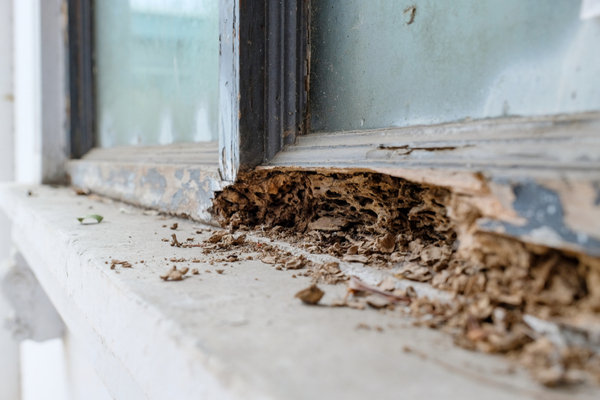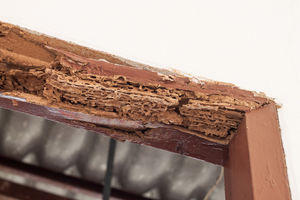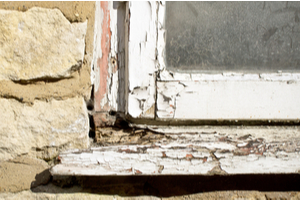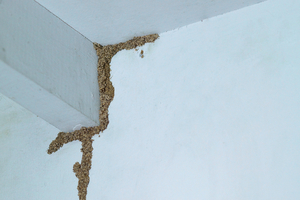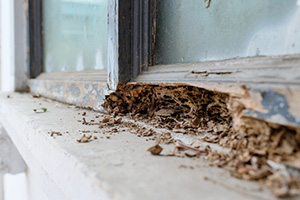
Wondering if the damage on your property might be the result of termites? The pest control experts at Griffin Pest Solutions are here to help!
Understanding the telltale signs of termite damage is crucial for Michigan homeowners and property managers. Termites are silent invaders, and their destructive habits can go unnoticed until significant damage has occurred. Below, we’ll explore the various indicators of termite infestations and what termite damage looks like. By becoming familiar with these signs, you can take proactive measures to protect your home and assets from the costly consequences of termite infestations.
How to Identify Termite Damaged Wood
Termite damage can vary in appearance depending on the type of termite and the extent of the infestation. Here are some common signs and what termite damage may look like:
- Wood Damage: Termites primarily feed on wood, and one of the most common signs of termites is damaged or hollowed-out wood. You may notice that wooden structures, such as beams, furniture, or flooring, appear damaged or weakened. Termites often consume wood from the inside, leaving a thin outer layer intact, which can make the damage hard to detect.
- Mud Tubes: Subterranean termites, which are common in many regions, including the United States, build mud tubes. These pencil-sized, mud-colored tubes run along the surface of walls, foundations, or other structures and provide protection for the termites as they move between their nest and their food source.
- Swarmers: Termite swarmers, also known as “alates” or “winged termites,” are reproductive termites that emerge from mature colonies to establish new ones. Seeing swarmers indoors or finding discarded wings can be an indication of a nearby termite colony.
- Frass or Droppings: Drywood termites push out their feces, which can look like tiny pellets or sawdust. Finding these pellets or “frass” near termite entry points is a sign of their presence.
- Blisters in Wood: Termites may create small blisters or bulges on the surface of painted or finished wood. These blisters can indicate termite activity beneath the surface.
- Damaged Paper or Cardboard: Termites are known to feed on paper and cardboard, so you might find damaged documents, books, or cardboard boxes in areas where termites are present.
- Tunnels or Galleries: Subterranean termites create tunnels or galleries within wood, often lined with mud, which can be visible if the wood is broken open.
It’s important to note that termite damage can often go unnoticed until it becomes extensive. Regular termite inspections by a pest control professional are crucial for early detection and prevention of significant damage. If you suspect termite activity in your home, it’s advisable to consult with a pest control expert for a thorough inspection and appropriate treatment.
Need An Estimate for Termite Control?
The Beginning Signs of Termite Damage
Early detection of termite activity is crucial for effective pest management and minimizing potential damage. Here are a few things to keep an eye out for:
- Discarded Wings: Termite swarmers, the reproductive members of the colony, may shed their wings after swarming to establish new colonies. Finding discarded wings around windowsills, doors, or in spider webs can indicate nearby termite activity.
- Blistering or Bubbling Paint: Termites can create small blisters or bulges on painted or finished wood surfaces. These imperfections can be early indicators of termite activity beneath the surface.
- Small Holes in Drywall: Termite damage may lead to small holes or punctures in drywall, and these areas may appear like pinpricks.
- Sagging or Buckling Floors: If your wooden floors begin to sag or buckle, it may be a sign of termite damage weakening the structural support.
- Clicking Sounds: Some termite species make clicking or rattling sounds when disturbed. You may hear these noises if you tap on or disturb a termite-infested area.
How to Prevent Termite Damage
Preventing termite damage is often more cost-effective and less troublesome than dealing with infestations after they’ve occurred. Here are essential steps to help protect your property from termite damage:
- Regular Inspections: Schedule routine termite inspections by a pest control professional. Professionals can detect early signs of termite activity and recommend necessary preventive measures.
- Termite Barriers: Install physical termite barriers, such as termite shields or chemical barriers, around the foundation of your home. These barriers create a deterrent that can help keep termites at bay.
- Foundation Maintenance: Keep your home’s foundation clear of soil and vegetation. Ensure that the ground slopes away from the foundation to prevent water from pooling near the structure, as excess moisture attracts termites.
- Proper Ventilation: Maintain good ventilation in crawl spaces and basements to reduce humidity levels, as termites are drawn to moisture. Consider using dehumidifiers if necessary.
- Wood Selection: When building or renovating, use termite-resistant wood, such as pressure-treated lumber. This wood is less appealing to termites and can help reduce the risk of infestation.
- Regular Maintenance: Keep your property well-maintained, addressing issues like leaky pipes, damaged roofs, and faulty gutters promptly. Fixing these problems reduces potential entry points for termites.
- Remove Termite Food Sources: Discourage termites by storing firewood, lumber, and wood debris away from your home. Additionally, clear away dead or decaying trees and stumps that can attract termites.
- Close Gaps and Cracks: Seal gaps or cracks in your home’s exterior, such as around windows, doors, and utility lines. Termites can exploit even tiny openings to gain access.
- Professional Pest Control: Consider ongoing termite control services from experts like Griffin Pest Solutions to create a protective barrier against termite infestations. Regular treatments and monitoring can be a proactive defense.
How to Fix Termite Damage
Fixing termite damage may require a combination of DIY efforts and professional assistance.
If your property has termite damage, it’s understandable that you would want to get that fixed right away. But before you begin tackling home repairs, you need to eliminate the existing infestation and establish a plan to prevent future ones as well. The best way to do this is by reaching out to your local pest control experts. It’s important to act promptly in order to prevent further deterioration of your home’s structure.
Are Termites Damaging Your Property? Give Us a Call!
If you suspect termite damage or have spotted early signs of infestation, don’t wait. Griffin Pest Solutions is your trusted partner in termite detection, removal, and prevention.
Our termite control experts will be able to identify the type of damage you’re dealing with, find your termites, wipe them out, and make sure they never come back. When you choose Griffin for your termite pest control, you get service that lasts – no ifs, ants, or bugs!
Still have questions? Want to schedule an appointment? Contact us today.
Back to Termite Exterminators – Control – Removal
